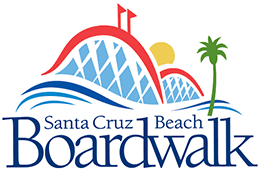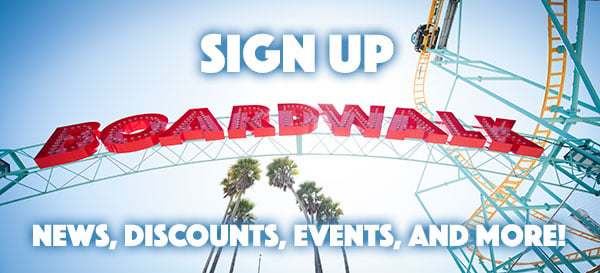As the only major seaside amusement park remaining on the West Coast, the Santa Cruz Beach Boardwalk offers a unique combination of classic and modern rides, a sandy mile-long beach, and a variety of attractions. California’s other seaside amusement parks such as Whitney’s Playland in San Francisco and the Pike in Long Beach closed decades ago, due to pressure from real estate developers.
The family-owned and operated Boardwalk has been a popular destination since the early 1900s.
“A key to our success is our ongoing effort to blend vintage and modern attractions,” said Charles Canfield, president of the Santa Cruz Seaside Company, which owns and operates the Boardwalk. “While we continue to open exciting new attractions, we also make sure to preserve the classic rides and family atmosphere that generations of visitors have cherished.”
In the Beginning
The Boardwalk’s roots go back to 1865, when John Leibrandt opened a public bathhouse near the mouth of the San Lorenzo River. Other bathhouses followed; scores of tourists began visiting Santa Cruz to enjoy this highly touted health benefits of bathing in salt water. Soon more concessions sprang up including restaurants, curio shops, and photo stands. Toward the end of the 1800s, Fred W. Swanton, considered one of the greatest promoters and entrepreneurs of his time, laid plans for a casino and boardwalk — a “Coney Island of the West.”
The first Casino opened in 1904 but survived only 22 months; on June 22, 1906, the uninsured building was completely destroyed by fire. Legend has it that Swanton was on the phone before the last wisps of smoke disappeared, lining up financing and ordering materials to rebuild. By summer’s end, famed architect William H. Weeks was drawing up plans, and in October a foundation had been laid for the new Casino. The new Casino included a ballroom, the Plunge indoor swimming pool, a pleasure pier, and boardwalk.
Some 500 people worked on the project, and on June 22, 1907, exactly one year after the devastating fire, the new attractions opened. More than 1,200 people attended the opening ball, and thousands more watched outside as the Casino and Boardwalk were illuminated by thousands of white lights.
And Then There Were RIDES
A few months after the opening gala, construction began on the Boardwalk’s first thrill ride, the L.A. Thompson Scenic Railway which opened in 1908. The four-minute coaster ran on one mile of wooden track and cost $35,000 to build.
In 1911 European woodcarver Charles I.D. Looff delivered a new merry-go-round, complete with hand-carved horses and two chariots. The carousel and its original 342-pipe, 1894 Ruth Und Sohn band organ is still in operation.
It was Looff’s son, Arthur, who convinced the Boardwalk to replace the Scenic Railway ride to make way for a “modern” wooden roller coaster. The Giant Dipper coaster opened in 1924 and soon became the park’s most popular ride; the Dipper’s ridership is now more than 60 million.
That’s Entertainment
Also in 1924, the first of many Miss California Pageants was held at the Boardwalk and Cocoanut Grove. The first winner, Faye Lanphier, went on to become Miss America. Concerts featuring some of the biggest names of the big band era: Artie Shaw, Benny Goodman, Lawrence Welk, and many other top name performers played at the Boardwalk’s Cocoanut Grove.
The 1950s and 1960s brought a Cocoanut Grove renovation and the addition of more Boardwalk thrill rides such as the Wild Mouse, Autorama, and Tilt-A-Whirl.
The year 1963 meant the end of the Boardwalk’s Plunge. Faced with rising costs and steadily declining interest in indoor swimming, the Plunge swimming pool was replaced with a new miniature golf course.
Four years later, the Boardwalk took advantage of innovations in the ski industry, allowing more compact ski lifts that were also suited for amusement parks. The Sky Glider, a scenic overhead ride installed in 1967, provides a panoramic view of the beach area.
Renovations in the early 1970s included the addition of rides such as the Round-Up, the Red Baron kiddie ride, a new Bumper Car ride, and a compact coaster ride called the Jet Star. Replacing the Wild Mouse in 1977 was Logger’s Revenge, an adventurous water ride that takes patrons on a winding run 55 feet above the Boardwalk and ends in a breathtaking descent.
The Renovating 1980s
The Cocoanut Grove was the focus of the company’s single most extensive construction project in 1981, when renovation and restoration transformed the facility into a multi-use conference and banquet center.
$10 million undertaking modernized the building’s kitchen and interior and returned many traditional Victorian aspects. The most visible addition of the project was the Sun Room, a 6,000-square-foot banquet room with a spectacular, retractable glass ceiling, allowing open-air dining or dancing.
On the Boardwalk itself, the 1981 renovation added new clothing and gift shops, plus a candy store and kitchen where Marini’s famous saltwater taffy is still made. In following years, the Boardwalk completed a number of major projects, including Cap’n Jack Flint’s Pirate Ship, several new adult and kiddie rides, and the transformation of the Autorama’s kid-sized freeway into the Great Auto Race.
Music returned to the main beach in 1988 when the Boardwalk began free summer concerts on the beach bandstand. Still going strong, the Free Friday Night Bands on the Beach concerts feature classic rock groups from the ‘80s, and ’90s.
The ‘Quake of ‘89
When the earth quaked on October 17, 1989, the exterior wall of the Plunge building was badly damaged, thus speeding plans to transform the facility into a major attraction. The resulting $5.2 million adventure center, Neptune’s Kingdom, includes a two-story miniature golf course, games, a cafe, and party area.
High Tech 1990s
The Hurricane, a thrilling metal coaster with 80 degree banking turns, replaced the 20-year-old Jet Star in 1992 as the fifth coaster in the park’s long history.
The Boardwalk moved further into the high tech world in 1995 when it opened a Laser Tag Arena.
As the 1990s progressed, the Boardwalk continued to add new and colorful rides to its lineup: Whirlwind, Crazy Surf, Chaos, Tsunami, and Kiddie Bumper Boats.
In 1994 the Boardwalk took over operation of the Surf Bowl bowling center across the street from the amusement park. A $3.5 million dollar renovation in late 2001 turned the center into a state-of-the-art bowling complex, renamed the Boardwalk Bowl.
The Twenty-First Century Arrives
The Boardwalk marked the year 2000 with the return of the popular Cave Train and a remodeled area near the river. Originally opened in 1961, the Cave Train (a dark ride with a prehistoric theme) was closed in 1997 for a major underground renovation project. Cave Train Adventure features original elements of the 1961 version as well as more modern-day technology. Housed in its original location, the Cave Train highlights the section near the river that has been remodeled with a new walkway and several new rides.
One of those new rides arrived in 2001 when Ghost Blasters brought comical and ghostly interactive fun to the area. In 2002, Rock & Roll arrived near the Logger’s Revenge. The thriller brings classic cars and rockin’ tunes together for a spinning experience. Not far from Rock & Roll, the Cliffhanger and Fireball (new additions in 2003) bring plenty of high-flying screams of joy to the park.
The Boardwalk Today
In 2019 the Boardwalk offers 40 rides and attractions. In addition, the park houses arcades with both vintage machines and hundreds of video games, a game deck, midway games of skill, food vendors, indoor miniature golf, a laser tag arena, and gift shops with everything from beachwear to sunglasses and jewelry.
The nearby Boardwalk Bowl features 26 lanes, Atomic Bowling, league play, kiddie bumpers, an arcade, the B.B. Eats café, and karaoke and live local bands at Coasters. The Cocoanut Grove complex hosts a variety of special events.
The historic Boardwalk amusement park is fronted by a mile-long sandy beach, which is cleaned and sifted throughout the year. Sunning, swimming, and sailing activities are popular, and the nearby Santa Cruz Municipal Wharf offers fishing, restaurants, and gift shops. A world-class surf spot is located a short walk away at Steamer Lane.
Boardwalk rides are open daily Memorial Day to Labor Day and most weekends and holidays during the year. Admission to the park is free. Season passes, all-day ride wristbands, single ride tickets, group rates, exclusive ride rentals, and corporate events are available.
The Boardwalk is located 35 miles from San Jose, 40 miles north of Monterey, and 70 miles south of San Francisco. Take Highway 1 or 17 to Santa Cruz and follow the signs to the beachfront. For information, call (831) 426-7433 or (831) 423-5590, or visit www.beachboardwalk.com

